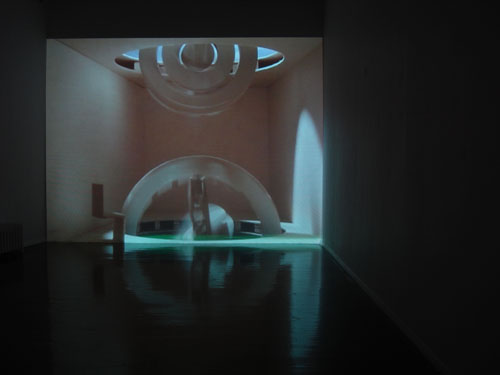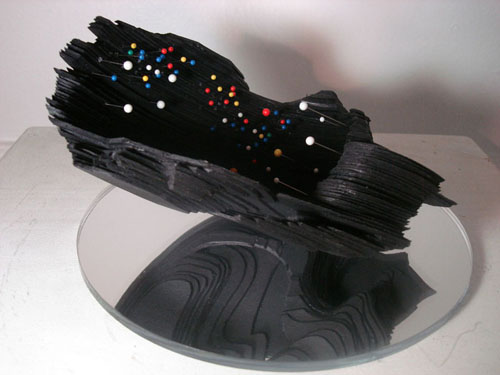Vidal Centeno was one of the first artists I considered as I began to work on this guest blog series. When I reached out to him with the idea, he was in the process of relinquishing his studio space to cut overhead expenses. The timing was fortuitous. Back in 2008, when I first met Vidal, he primarily made constructs of deconstructed objects: an A117 jet fighter, a 9mm handgun, and a chandelier in the form of a GEnx jet engine. Now, Vidal is working on a collaborative text based project, entitled “Lyra, as a part of 8 to 8: STATE OF CREATIVE EMERGENCY PROJECT.” Presented by the artist Blanka Amezkua, six participants will meet at Union Square Park, at which point they’ll receive a package containing a short narrative. Each participant will then continue this narrative independently, and in so doing collaborate on a hypertext novel. Our interview discusses how money and income and the loss of Centeno’s studio precipitated a move to projects more ephemeral in nature.

Vidal Centeno. “Choros to the Catastrophic,” 2010. Bristol paper, wire rope, fluorescent light, 53 x 26 inches (two views).
BC: What type of work do you create, and why? As you make the work, do you consider the cost involved in the project? How do you strike a balance between the cost of stuff and the work in the studio?
VC: For the past eight years I’ve assembled small, complex three dimensional constructs as well as larger, site specific installations using lighting and video. This however is changing. Maintaining a separate studio/storage space in this town has become an issue as of late.
BC: Why has maintaining a separate studio/storage space become an issue of late? Do you care to elaborate?
VC: Keeping a separate studio/storage space is just too expensive. I actually see this as a positive development and I’m quite excited about what’s to come. This process of change is essential. Just as your line of inquiry changes, so do the methods you employ to realize a project. I definitely consider cost when it comes to any project, you have to. What I’ve found in my experience is that getting around the issues of cost and feasibility can lead to some rather creative solutions.
My budget on projects is usually small. Unless of course the budget for a particular project is being supplemented by a grant or stipend.
BC: How do you manage your money, and how do you earn income? I want to know how economics, and money-management, affects your decisions inside and outside the studio.
VC: I earn my income as a registrar. Having said that, I have to live as frugally as possible. Economics in this day and age affects some of the decisions I make outside the studio with regards to sustainability. Economics has affected my studio practice in that I can no longer maintain a studio. So what remains after the studio is gone? What remains is my creativity and many possibilities. What I can’t allow economics to affect are my ideas, my curiosity, and my sense of wonderment.
BC: If you seek monetary compensation as an artist, do you see it as a possible compromise to the type of work you create, and your integrity as an artist?
VC: If the line of inquiry you’re on is genuine and by that I mean, you have a genuine sense of curiosity regarding an idea or the subject matter you’re exploring and if the work that comes out of that rigorous process is honest, if someone comes along who appreciates what you’ve done and offers to buy that work from you, what’s the problem?
BC: Do you work to support your art, or does your art support you?
VC: You could say we’re codependent. I definitely support my art but it also supports me in immeasurable ways.
BC: To clarify, how does art support you in immeasurable ways? Can you elaborate?
VC: If travel over the unfathomable is the only condition; then my preferred method of conveyance is art.

Vidal Centeno. “1:24” (video still installation), 2010. View of single channel video, dimensions variable.
BC: As an artist, how do you monetize your time, and how do you assign a monetary value to your studio practice?
VC: That’s easy, pay yourself a salary! A gallerist interested in selling my work asked me how I arrived at the price I was asking for a particular piece. My work can be very labor intensive. I broke it down for him, material costs, the time I put into realizing the piece, the rate at which I was paying myself and the uniqueness of the work. I also told him I had to factor in the 50% he’s taking for himself. He couldn’t deal, so I walked.
BC: What percentage of your income is derived from outside sources associated with your art? Teaching, lecturing, visiting artist?
VC: None whatsoever.
BC: The recent economic collapse laid waste to philanthropic giving, government subsidies, and slashed market prices for most artists. As an artist, there are no guarantees. How did you manage the current fiscal crisis, and how did it affect your work inside and outside the studio?
VC: Artists are always working in a recession, what’s new? Unless of course you’ve achieved critical/commercial success in which case this question doesn’t apply to you. Currently I’m in the process of experimenting with different methods of realizing new projects. One of these projects involves photographically documenting controlled, ephemeral phenomena. I’m also using years of experience working three dimensionally and with lighting installations in developing prototypes for a series of lighting structures that would be marketed independently.

Vidal Centeno. “1:24” (video still installation – alternate view), 2010. View of single channel video, dimensions variable.
BC: Who would you market the light sculptures too?
VC: To that segment of the general public who would appreciate and desire something unique, handmade and functional. It’s a bespoke object.
BC: Have you purchased the artwork of another artist?
VC: I have yet to purchase an artwork from another artist. I would like to. Perhaps when the resources and opportunity present themselves I’ll be in a better position to make such a purchase. On the other hand, I have traded artworks with other artists.
BC: You have exhibited your work in numerous nonprofit institutions over the years. According to the 2010 W.A.G.E. Survey (Working Artists for the Greater Economy), nearly 60% of artists that exhibited their work in cultural institutions did not receive any form of payment, compensation or reimbursement. It’s as if the art world expects artists to work for free. What other profession expects this of its workers, to give services away for free?
VC: Actually the culinary field has similar expectations of some of its own. One of the best stories I’ve heard regards this famous Spanish chef that used to run a high-end restaurant in Catalonia, Spain. This guy would get all these young, impressionable, naïve would-be cooks/chefs to work for him for two years, unpaid! I guess you could look at it as akin to getting an MFA. After two years he would then decide if he wanted to keep you on and start paying you. I recently read somewhere that the restaurant is now closed.
As much as I support and applaud certain non-profit art institutions, particularly those that actually exhibit and support emerging artists, these institutions shouldn’t expect artists, particularly emerging artists, to participate without some manner of recompense.
BC: Despite lack of remuneration, many artists agreed to the offer. Why?
VC: Depending on which cultural institution the exhibition is occurring at, such an exhibition could be be seen as an opportunity by some artists.







Pingback: Artist Loses Studio, Goes Gonzo « HE SAID SHE SAID